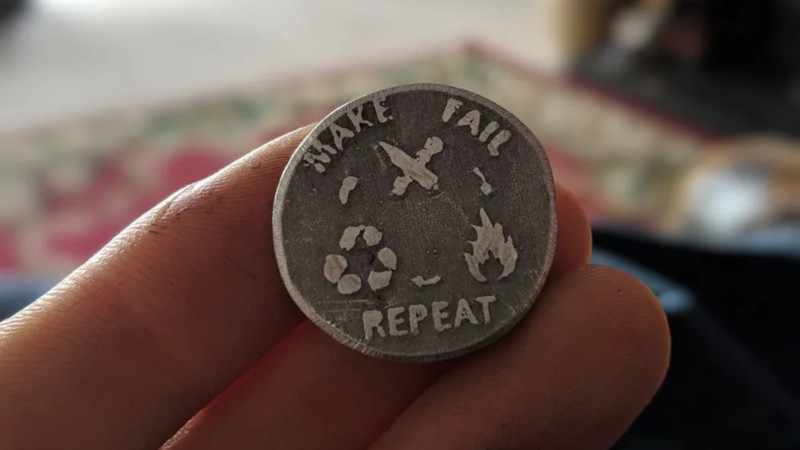[MakeFailRepeat] was heading to MakerCentral in Birmingham, an event to which many makers were bringing coins to swap and trade. Wanting to get in on the action, he decided to etch some coins of his very own.
Etching aluminium is a simple process, readily accessible to the average maker. [MakeFailRepeat] started with an aluminium bar, and applied sticky-backed vinyl to the surface. This was then lasercut with the coin artwork, and the pieces removed to leave a negative space design for etching. With the resist layer in place, the aluminium was placed in a bath of salt water, and attached to the positive electrode of a DC supply or battery. With the negative electrode attached to a bolt, the aluminium is left to etch, with care taken to avoid over-etching. As a final finishing step, the coins were then placed in a cobbled-together rock tumbler, using scrap 3D printer filament as media.
The coins are a little rough around the edges, but we think they’re great for a first attempt. There’s plenty of different ways to etch; toner transfer is a particularly popular method. Video after the break.
















People say that laser cutting of vinyl stickers produces very nasty fumes, that’s why nobody does it.
yup, best to use a plotter/vinyl cutter. They are fairly inexpensive compared to laser cutters.
laser + vinyl = chlorine gas, definitely on the not recommended list or am I missing something?
You’re absolutely right. Both the vinyl and the etching process give of dangerous gas. It was a well ventilated area and the laser vents straight outside. Still I’d advise a vinyl cutter instead of the laser.
Quite a few species of concern arise from thermal degradation of PVC, namely, carbon monoxide, vinyl chloride monomer, and hydrochloric acid (HCl) as gas, among others. Apart from health effects, the HCl could certainly affect machine parts like ground steel rod surfaces over time with corrosion.
The quantities are likely to be low for this sort of job, making dilution and extraction the best engineering strategies if it can’t be done some other way.
See
https://oem.bmj.com/content/oemed/39/3/239.full.pdf
https://www.epa.gov/sites/production/files/2016-09/documents/vinyl-chloride.pdf
Arguably, laser cutting polyurethanes is a bigger problem, due the liberation of isocyanate species which can sensitize some and then trigger quite severe asthma attacks in these predisposed individuals.
You’re missing the HCl, carbon monoxide and vinyl monomer, along with other species from thermal degradation of the PVC.
The HCl, as well as irritating mucous membranes, can also cause surface pitting and corrosion of parts like ground steel rods in the laser cutter.
It seems links to the pdf directly get blocked in the comments, but here’s the abstract of a nice write up of heat issues in a PVC processing plant which links to the full text
https://oem.bmj.com/content/39/3/239
Dilution and exhaust ventilation would be prudent for this sort of cutting.
Looking good! Though I seem to remember a friend and I etching aluminium with much better results (i.e. cleaner edges, better resolution) using the standard PCB copper etching method – photo-resist, UV light, and ferric chloride.
You’re right, I made some brass versions after these (didn’t video it though) using ferric chloride and they were much more defined.
If, instead, they had etched some tool steel then the result would have been coining dies, and as many coins as they wanted.
I’ve seen EDM used to make the coin blank out of tool steel. More $$ but I can print more silver coins when I need to pay for things
As this video shows, deep electro-chemical etching produces fuzzy and unrecognizable shapes. That’s because the process erodes around the mask. It should also be noted that chlorine gas is produced through electrolysis of table salt. Salt should NEVER, EVER be used as an electrolyte. There are better methods that don’t produce chlorine gasses.
Regarding NaCl electrolyte – evolution of chlorine is generally only a problem if the etching voltage is too high, and if the anode isn’t a reactive metal (aluminum is *very* reactive), and/or if there’s acid present in the electrolyte. The preferred reaction when chlorine *is* produced is to combine with the free oxygen and sodium hydroxide that is also generated, which produces sodium hypochlorite (bleach). Acids will tend to prevent the chlorine from being able to remain as hypochlorite, but since the etching process produces both sodium and aluminum hydroxides, the solution is usually at a high enough pH to be safe as long as no additional acid is added. IME, it takes a fair bit of carelessness in the process to get free chlorine gas.
I’ve been able to do etches on 38mm blanks to a depth of half a millimeter or so with quite clean edges using UV dry film photoresist and a constant-current power supply, and limiting the current to around 200 milliamps (you want to keep the etching voltage under about 2 volts, and the lower the better), and have never had problems with free chlorine being produced. Lower currents also produce cleaner etches – at 100 mA I can get edges that are razor-sharp. Yeah, my etches take longer (about an hour at 200 mA to get to the aforementioned 0.5 mm depth), but I’m more than happy to give up expediency for safety. If you can’t get that etching voltage low enough, there’s probably not enough salt in the solution.
This isn’t to say that chlorine gas isn’t a safety issue – it most definitely is, and it WILL do bad things to you if it starts being produced. To be absolutely safe, it’s not a bad idea to do the etching outside or somewhere you have plenty of ventilation. All I’m saying is that with the proper process in place, it’s possible to safely use a solution of table salt as an electrolyte without producing free chlorine to begin with.